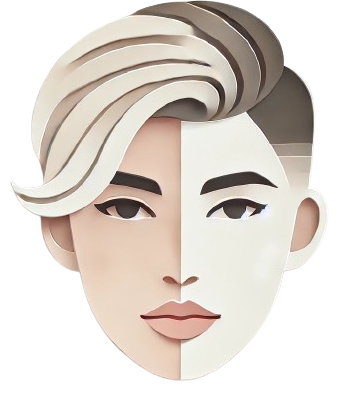“I saw the angel in the marble and carved until I set him free.” Michelangelo
The subspecialty of gender-affirming surgery is unique in that it represents much more than merely complex surgery confirming what many of our patients have often known their whole lives. It is often the end of a relentless journey of self-sacrifice, perseverance and a belief in that which cannot be seen. It is the ultimate culmination of marrying the physical self with their spiritual and psychological self after a lifetime of being consumed by the mismatch.
Perhaps the most personal and exposed part of one’s physical self is the face. It represents your identity, how you feel and perceive the world, and rightly or wrongly, how others perceive and receive us. A person’s face is far more difficult to align with one’s gender identity even with masterful makeup and hair artistry. There are often structural features that always remain as a sign of someone’s physically assigned secondary sexual characteristics.
What Is Facial Feminisation Surgery?
The technique used to describe the alteration of facial proportions in order to feminise the face is called facial feminisation surgery or FFS, and is performed in our Sydney practice by specialist plastic surgeon, Dr Robert Knight.
There are a variety of techniques that Dr Knight can perform to provide a softer and more feminine facial appearance. This typically involves changes to the shape and size of specific features, such as the forehead, nose, and jaw.
Meet your Surgeon

Dr Robert Knight
Meet your Surgeon
Dr Robert Knight FRACS:
- Registered Specialist Plastic Surgeon
- AHPRA MED0001198549
Education and Training:
- Attended medical school in South Africa, and trained at the internationally renowned Baragwanath Hospital
- Awarded a Cyanamid Pharmaceutical Scholarship, the Medical Students Council Award and the Graham Wilkinson Medal
- Member of the Royal College of Surgeons of Edinburgh
- Awarded the LGI cardiothoracic prize and presented at several conferences in London, Stockholm and Cologne
What Facial Feminisation Surgery Procedures Are Available?
The main facial structures that are commonly altered in this procedure are as follows:

Hair Advancement Techniques
Men have higher hairlines, lower brows and thinning temple hair. Conversely women have lower hairlines (±6cm), higher brows and fuller temple hair. By elevating the male brow and advancing one’s scalp, one is able to achieve a more female forehead.
By moving your hairline into a more feminine position, one is often able to transform how their face is perceived; many transgender patients are often very pleased merely by this rudimentary move. In conjunction with forehead contouring surgery and brow lift surgery, your entire upper face will appear more feminine and within the norms of the binary feminine phenotype.
Forehead Contouring
Nowhere else in the male face is one more masculine than in the forehead region. Men have a distinct characteristic called frontal bossing – this is a prominence of the lower forehead just above the eyebrows and a steeper slope of the forehead compared with females. Women conversely have a more convex contour with more vertical height and a softer transition to their hairline. Men have a relatively sloped forehead compared with females in whom they are more rounded.
Temporal Fossa Augmentation (Filling Hollow Temples)
Often there may be recesses associated with one’s facial appearance. An area where this is often encountered is the temporal fossa. This is the area that lies to the side of your eye sockets and above your cheek bones. It is also called your temple. Improvements are made to this area to feminise and revitalize the facial region.
Cheek Contouring
While there are no identifiable gender biases related to the size and position of one’s cheeks, all genders look healthier and facially balanced when their cheekbones look robust and elevated. It is important to emphasize that the size of one’s cheeks should be kept in proportion with the rest of one’s face, and that this area of facial aesthetics should be done as one of the last procedures after the forehead and cheek regions have been enhanced.
Rhinoplasty
Male noses are generally larger than those of females. This is true of most of the dimensions assessed. Subtle and reproducible angles are also defined which, although very subtle, make for the stereotypical male and female noses. Gender specific nasal characteristics are as important as forehead dynamics in terms of facial recognition and identification of one’s chosen expression of gender if you wish it to be binary. Rhinoplasty can alter a masculine nasal appearance to align with more feminine characteristics.
Genioplasty
Men have vertically longer and wider chins that are less pointed. This is a very common area of adjustment for transgender FSS due to the marked discrepancies and ease of correction as well as the very specific nature of differences between the genders. Men have chins that are approximately 20% taller than females and also are more square compared with female lower faces. Their chins are also wider and have lateral (side) prominences that gives one a chiselled look while females have a softer and more oval chin that has no chiseling at all. The midline of the jaw is also less prominent and the dimple is often less pronounced.
Jaw Contouring: Mandible Shaving/Lower Jaw Tapering/Angle Reduction
Men have a wider, fuller jaw and a taller and fuller mandible angle. Females have a smaller tapered jaw bone. Most importantly, men have significantly wider angles of their lower jaws from the side which are bowed out more prominently due to the much stronger muscles required during eating.
Laryngeal Shaving/Augmentation
One’s Adam’s apple is for many people the very definition of masculinity. It is often the primary concern for many patients that approach me for help, and it heralds the dreaded pubescence that many transgender patients feel betray them.
What Can I Expect in Facial Feminisation Surgery Recovery?
The details of your recovery after facial feminisation surgery will depend upon the specific procedures you undergo. In general, bandages are typically placed over the incisions, and small tubes may be placed underneath the skin to allow for excess fluid to drain. Your surgeon will provide you with post-operative instructions for wound care, medications to use, and when you can resume normal activities. You will need to return to our office for follow-up visits, during which your surgeon will monitor your progress with healing and answer any questions you have. It may take several weeks for facial swelling to go down. As this continues to fade, your final results should become more apparent.
Although scarring cannot be avoided with surgery, our surgeons utilise advanced techniques to make incisions as small as possible and in areas that can be easily concealed. Patients can expect their scars from facial feminisation surgery to gradually fade over the course of the first year. Most individuals find the scarring from their procedures is well worth the benefits they receive, allowing them to achieve a more feminine facial appearance that better represents their true gender.
How Much Does Facial Feminisation Surgery Cost?
The cost of facial feminisation surgery is different for every patient, as the procedure is highly customised to the needs and aesthetic goals of each individual. Factors that may affect your total cost include the surgeon’s fee, surgical facility, anesthesia, medication, and post-surgery garments. Once you have consulted with one of our specialist plastic surgeons, our team can provide you with a personalized cost quote, detailing the fees associated with your upcoming procedure.




